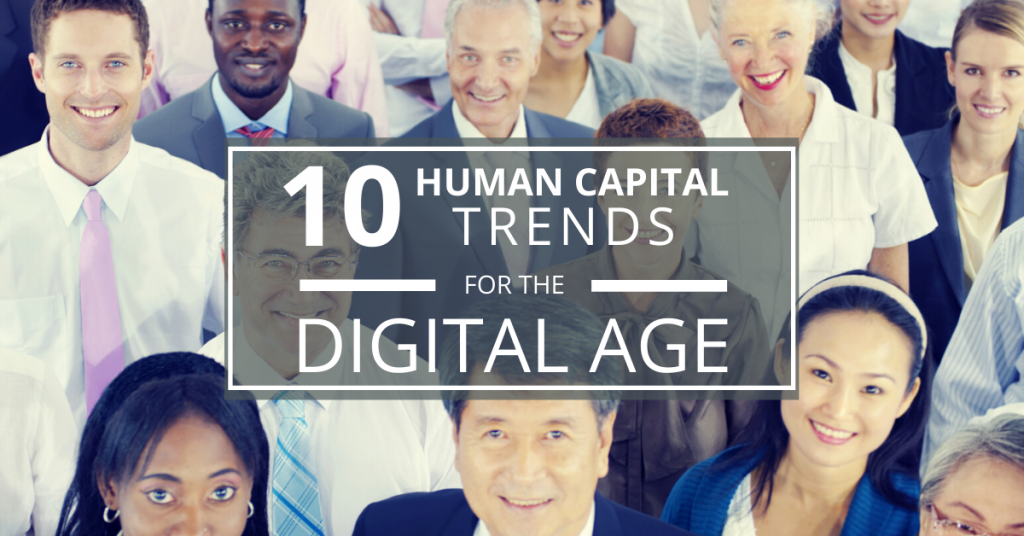Is your firm ready to address the top 10 trends regarding human capital? In a recent survey conducted by Deloitte, they asked more than 10,000 business and Human Resources leaders from 140 countries about how to better organize, manage, develop, and align people at work.
Here are the top 10 trends they discovered across the board that takes into consideration the way the digital age is re-shaping the workplace and the workforce, ordered by importance.
1. The organization of the future: Arriving now
Many organizations understand the importance of adapting to technology; however, whether or not they have the capacity to do so is another story. Organizations that set themselves up for success now and in the future are ones that move faster, adapt quickly, learn more rapidly, and embrace dynamic career demands.
2. Careers and learning: Real time, all the time
In the past, employees learned to gain skills for a career; now, the career itself is a journey of learning. Today, organizations can position themselves and their staff for success by providing continuous learning opportunities and a deeply embedded culture of development. Diving into new tools that have entered the market such as content, video, and mobile learning solutions is a step toward this direction.
3. Talent acquisition: Enter the cognitive recruiter
Although recruiters can easily reach and research their candidates through tools such as social media, the opposite is also true. Candidates are now able to learn more about companies and organizations online and whether they would be a good fit. The biggest disruptor in talent acquisition today is experimentation with tech solutions and services to find candidates through cognitive technologies such as artificial intelligence, machine-to-machine learning, or robotic process automation.
4. The employee experience: Culture, engagement, and beyond
While company culture is important, many organizations are aiming to improve the employee experience as a whole. Millennials today are expecting a work experience that is engaging, productive, and enjoyable. Using a variety of feedback tools, wellness and fitness apps, and employee self-service technologies, HR and management are looking to build programs, teams, and strategies that improve the overall employee experience.
5. Performance management: Play a winning hand
Over the last 5 years, organizations have changed the way they measure, evaluate, and recognize employee performance. But today, new practices are becoming clearer and more standardized to adapt agile goal management, check-ins, continuous feedback, and reward systems. 90% of companies using redesigned performance management see direct improvements in engagement.
6. Leadership disrupted: Pushing the boundaries
Leadership development continues to be challenging for companies around the globe. This is due to the fact that many organizations need a completely new and different leader than the ones they’ve seen in the past; ones who can build teams, keep people connected, and drive a culture of innovation, risk tolerance, and continuous improvement. They need digital leaders.
7. Digital HR: Platforms, people, and work
Human Resources (HR) is also expected to take on a larger role nowadays to help organizations be more digital rather than just incorporating more digital processes. Such a digital transformation must first start in HR as they gather and explore new technologies, platforms, and ways of working, which can then be implemented into organizations to streamline their protocols and processes both internally and externally.
8. People analytics: Recalculating the route
Analyzing sales and revenue isn’t the only type of analytics that should be going on in companies. People analytics is a must as well. This refers to investing in programs to use data for all aspects of workforce planning, talent management, and operational improvement. People analytics are enabling organizations to conduct real-time analysis at the point of need in the business process.
9. Diversity and inclusion: The reality gap
Diversity and inclusion has become a CEO-level issue around the globe. While businesses understand the importance of this issue, the reality is that results appear to be too slow. CEOs need to take responsibility for better implementation in order to address concerns regarding bias and equality in the workplace.
10. The future of work: The augmented workforce
With all these changes occurring, many organizations are reconsidering how they design jobs, organize work, and plan for future growth. This is referred to, by many, as the augmented workforce. As technology continues to evolve and change professions, organizations must rethink the roles their employees will play in the future as they adapt to the digital age.
To learn more about how your firm can prepare for and address these trends, see the full report here: 2017 Deloitte Global Human Capital Trends
